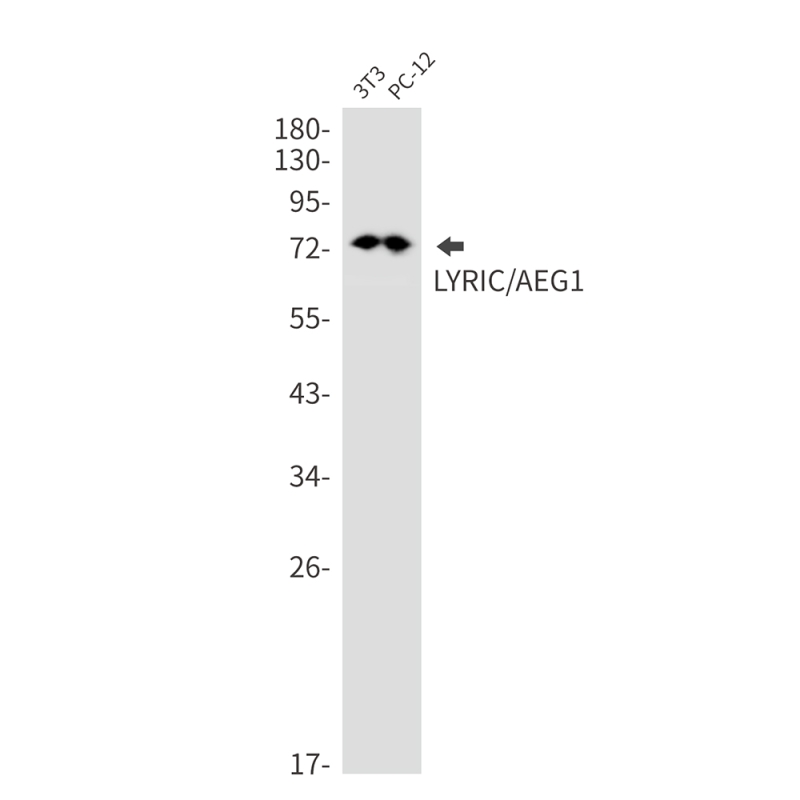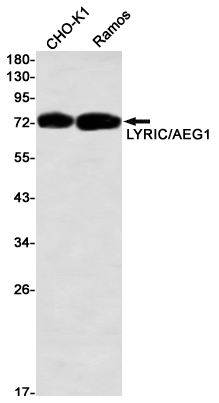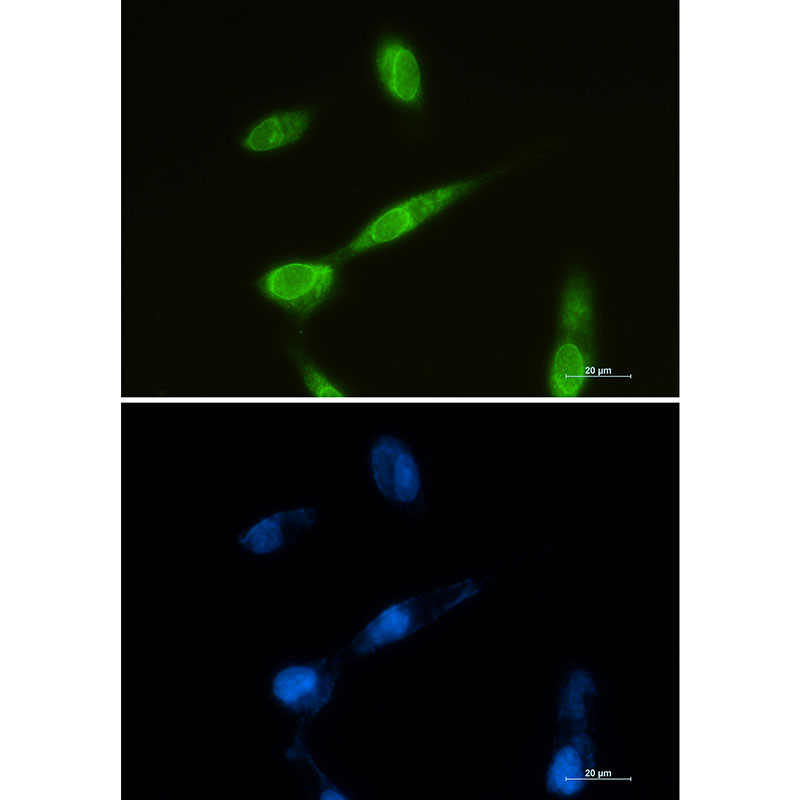



| WB | 1/500-1/1000 | Human,Mouse,Rat,Hamster |
| IF | 咨询技术 | Human,Mouse,Rat,Hamster |
| IHC | 1/50-1/100 | Human,Mouse,Rat,Hamster |
| ICC | 1/50-1/200 | Human,Mouse,Rat,Hamster |
| FCM | 咨询技术 | Human,Mouse,Rat,Hamster |
| Elisa | 咨询技术 | Human,Mouse,Rat,Hamster |
| Aliases | MTDH; AEG1; LYRIC; Protein LYRIC; 3D3/LYRIC; Astrocyte elevated gene-1 protein; AEG-1; Lysine-rich CEACAM1 co-isolated protein; Metadherin; Metastasis adhesion protein |
| Entrez GeneID | 92140 |
| WB Predicted band size | Calculated MW: 64 kDa; Observed MW: 75 kDa |
| Host/Isotype | Rabbit IgG |
| Antibody Type | Primary antibody |
| Storage | Store at 4°C short term. Aliquot and store at -20°C long term. Avoid freeze/thaw cycles. |
| Species Reactivity | Human,Mouse,Rat,Hamster |
| Immunogen | A synthetic peptide of human LYRIC/AEG1 |
| Formulation | Purified antibody in TBS with 0.05% sodium azide,0.05%BSA and 50% glycerol. |
+ +
以下是关于LYRIC抗体的3篇模拟参考文献,涵盖其功能及研究应用:
1. **文献名称**:*LYRIC/AEG-1 Antibody Reveals Its Role in Promoting Tumor Metastasis via NF-κB Pathway in Breast Cancer*
**作者**:Chen L., et al.
**摘要**:本研究通过免疫组化和体外实验,证实LYRIC蛋白(AEG-1)在乳腺癌中高表达,并通过激活NF-κB信号通路促进肿瘤细胞侵袭和转移。抗体的特异性验证为靶向治疗提供了潜在工具。
2. **文献名称**:*LYRIC Antibody-Based Detection of MTDH in Hepatocellular Carcinoma: Correlation with Prognosis and Drug Resistance*
**作者**:Wang Y., Zhang H.
**摘要**:利用LYRIC抗体检测肝癌组织中MTDH蛋白表达水平,发现其高表达与患者预后不良及化疗耐药性显著相关,提示其可作为肝癌治疗的生物标志物。
3. **文献名称**:*Mechanistic Insights into LYRIC-Mediated Angiogenesis in Glioblastoma Using Specific Antibody Targeting*
**作者**:Roberts K.S., et al.
**摘要**:通过LYRIC抗体阻断实验,揭示其在胶质母细胞瘤中通过调控VEGF通路促进血管生成的作用,为抗血管生成疗法提供了新靶点。
以上文献示例聚焦LYRIC抗体在癌症研究中的应用,涵盖分子机制、预后评估及治疗潜力。
LYRIC (lysine-rich CEACAM1 co-isolated), also known as MTDH (metadherin) or AEG-1 (astrocyte elevated gene-1), is a multifunctional oncoprotein first identified in 2002. It gained attention due to its overexpression in diverse cancers, including breast, prostate, liver, and brain tumors, where it correlates with poor prognosis, metastasis, and therapy resistance. Structurally, LYRIC contains multiple functional domains enabling interactions with signaling pathways (e.g., NF-κB, PI3K/AKT, Wnt/β-catenin) and cellular compartments (nucleus, endoplasmic reticulum, cell membrane).
LYRIC antibodies were developed to study its role in carcinogenesis and molecular mechanisms. These antibodies enable detection of LYRIC’s expression patterns, subcellular localization, and protein-protein interactions via techniques like immunohistochemistry, Western blot, and immunofluorescence. Research using LYRIC antibodies revealed its involvement in angiogenesis, invasion, chemoresistance, and stemness maintenance. Additionally, LYRIC antibodies have been explored as potential diagnostic tools or therapeutic agents, given LYRIC’s dual role as a biomarker and therapeutic target. Challenges remain in standardizing antibody specificity due to LYRIC’s complex isoforms and post-translational modifications. Nonetheless, LYRIC antibodies remain vital for elucidating its oncogenic functions and translational applications in precision oncology.
×